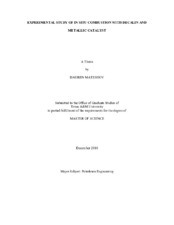| dc.description.abstract | Using a hydrogen donor and a catalyst for upgrading and increasing oil recovery during in situ combustion is a known and proven technique. Based on research conducted on this process, it is clear that widespread practice in industry is the usage of tetralin as a hydrogen donor. The objective of the study is to find a cheaper hydrogen donor with better or the same upgrading performance. Decalin (C10H18) is used in this research as a hydrogen donor. The experiments have been carried out using field oil and water saturations, field porosity and crushed core for porous medium.
Four in situ combustion runs were performed with Gulf of Mexico heavy oil, and three of them were successful. The first run was a control run without any additives to create a base for comparison. The next two runs were made with premixed decalin (5 percent by oil weight) and organometallic catalyst (750 ppm). The following conditions were kept constant during all experimental runs: air injection rate at 3.1 L/min and combustion tube outlet pressure at 300 psig. Analysis of the performance of decalin as a hydrogen donor in in-situ combustion included comparison of results with an experiment where tetralin was used. Data from experiments of Palmer (Palmer-Ikuku, 2009) was used for this purpose, where the same oil, catalyst and conditions were used.
Results of experiments using decalin showed better quality of produced oil, higher recovery factor, faster combustion front movement and higher temperatures of oxidation. API gravity of oil in a run with decalin is higher by 4 points compared to a base run and increased 5 points compared to original oil. Oil production increased by 7 percent of OOIP in comparison with base run and was 2 percent higher than the experiment with tetralin. The time required for the combustion front to reach bottom flange decreased 1.6 times compared to the base run. The experiments showed that decalin and organometallic catalysts perform successfully in in situ combustion, and decalin is a worthy replacement for tetralin. | en |


